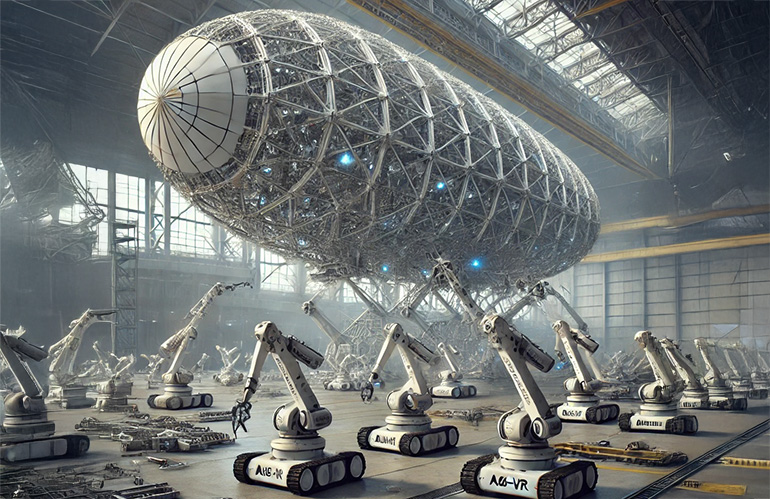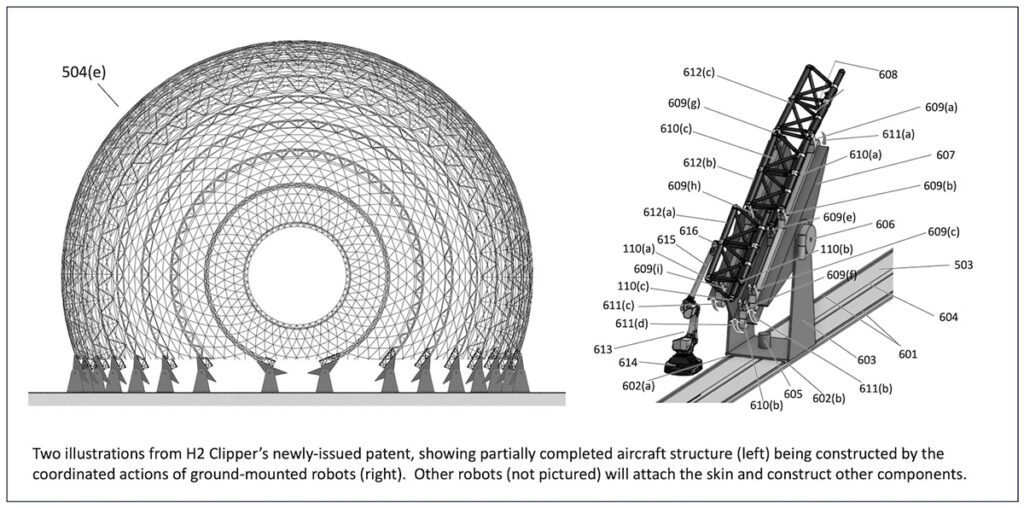Iván Hernández Dalas: Beyond the assembly line — swarm robotics emerge

A computer-generated image of futuristic aerospace assembly with swarm robotics. Source: World Business Academy
The evolution of manufacturing technology has continually progressed to meet the growing demands for efficiency, sustainability, and innovation. As industries adapt to meet these challenges, one area of exploration has emerged as a frontrunner: swarm robotics.
In the first part of this discussion, we looked at the evolution of automated production in automotive and aerospace. As with many great ideas, the concept for swarm robotics for large, complex manufacturing came from necessity.
As the principal designer of a revolutionary new aircraft, the H2Clipper, we procured dozens of basic patents for building a 100% “green” lighter-than-air dirigible for delivering liquid hydrogen from where it was able to be produced at the lowest cost to areas with the greatest need for clean energy.
In order to carry up to 400,000 lb. (18,143.6 kg) of liquid hydrogen in one direction and an equal amount of freight in 20-ft. (6-m) containers in the opposite direction, the airship needs to be 1,000 ft. (304 m) long and 200 ft. (60.9 m) in diameter at its midpoint.
When we completed the basic R&D design for the aircraft using the advanced computer systems available to us from our partners at Dassault’s 3D Systémes, I realized that mass-producing these airships would require a completely new approach to manufacturing. A traditional assembly line would need a hangar over 25 stories tall and several miles long, making production of the aircraft impractical and uneconomic.
The breakthrough came from an unexpected source: a colony of ants. As I watched them transport a large leaf—without a leader, without hesitation, and yet in perfect harmony—it struck me: this was nature’s answer to manufacturing. Ants don’t rely on linear processes. Rather, they operate as a decentralized swarm, adapting dynamically to their environment.
What if robots could do the same—coordinating autonomously to assemble large, complex structures?
Applying swarm principles to large-scale construction
Of course, the idea of swarm intelligence is not new. Researchers in artificial intelligence, robotics, and even military strategy have explored how self-organizing systems—like ant colonies, schools of fish, and flocks of birds—solve complex problems without centralized control.
The concept has been applied to software algorithms, drone coordination, and even logistics planning. But no one had yet attempted to apply these principles to the construction of large-scale structures. That was the missing piece. That was the insight that led to the birth of swarm robotics for aircraft, spacecraft, and airship manufacturing.
With the modest background knowledge of AI that I possessed, it was immediately obvious that robotic programming was advancing beyond conventional AI to something we now call generative AI—although that term wasn’t formally introduced until after we filed the patent.
Nevertheless, in the patent, we articulate a hierarchical progression of programming required to achieve full genAI capability, ensuring that our intellectual property encompasses all three phases of development. As previously described, “Level 1” focuses on programming multiple ambulatory and floor-mounted robots to operate in unison.
These mobile and stationary robots would assemble the airship from the ground up without requiring any movement of the structure until it is fully built and ready to exit the hangar. This foundational stage establishes coordinated, automated assembly, setting the groundwork for more advanced AI-driven operations. Our partners at Dassault Systémes have expressed interest in providing this level of robotic programming.
Companies pursue adaptive robotics
“Level 2” programming refers to the transition from conventional automation programming to adaptive, AI-driven robotics, where robots not only execute tasks but also self-regulate and coordinate their functions dynamically. At this stage, the system moves beyond pre-programmed repetition and introduces machine-learning algorithms that enable real-time collaboration and autonomous problem-solving—each being critical steps for decentralized manufacturing.
As described in the patent, we are not starting from scratch in reaching this level. Companies like Arrival have already demonstrated the potential of autonomous robotics in manufacturing, deploying self-aware robots that coordinate without a conventional assembly line.
Tesla’s Gigafactories, while impressive, still rely on a linear production model—using automation to optimize existing processes rather than redefining them. Arrival took a step further with its Microfactories, proving that flexible, autonomous robotics can replace traditional fixed tooling and conveyor systems. This innovation provides a strong foundation for advancing swarm robotics in aerospace.
However, scaling this approach from a car or minivan to account for the size and complexity of assembling aircraft and aerospace structures introduces an entirely new level of demands. Unlike automotive manufacturing, which deals with smaller, modular components, the fabrication of large aerospace assets requires a higher degree of autonomous coordination, precision, and adaptability.
As described in our patent, swarm robotics at Level 2 leverages Arrival’s innovations while extending them into a domain where traditional factory footprints and conventional automation techniques are no longer viable.
Editor’s note: Electric van developer Arrival declared bankruptcy and sold its assets in March 2024 to Canoo, whose assets including KUKA robots will be auctioned off next week.
Generative AI to enable self-learning systems
Achieving “Level 3” robotic programming requires teaching the Level 2 software to “understand” the parameters of what we taught it to do and how. The system could then begin teaching itself. That is the point where one crosses over to Level 3 or generative AI.
We believe that genAI could eliminate assembly lines. Humans, with our limited processing capability, will not be able to define the myriad of relationships that have to exist from second to second if we intend for the robots to act with one mind as ants do.
Creating “smart” machines is so complex an undertaking that we have to create the programming equivalent of millions and millions of synapses firing simultaneously every microsecond with a variety and speed no human could program. GenAI can and will—and it won’t stop with aircraft manufacturing.
The robotic manufacturing approach we described in the patent could ultimately be utilized for an endless array of large structure manufacturing and eventually for smaller scales as well. No one alive has yet seen the factory of the future, but it is coming as the power of genAI is unleashed through the processes we disclosed.

A diagram of a swarm robot assembly for a dirigible from a recent patent. (Click here to enlarge.) Source: World Business Academy
Swarm robotics to shape the future of aeronautical assembly
As noted above, there are numerous commercial, environmental, and safety advantages for fabricating aircraft with swarm robotics. Beyond those near-term manufacturing and financial advantages, there are other benefits, such as advanced design.
It is hard to imagine that swarm robotics won’t influence future designs for aircraft, autonomous drones, military vehicles, electric short-range passenger vehicles such as sky taxis, and spacecraft. History shows that new production techniques give way to new human systems.
This is true from the Bronze Age, when humans learned to combine different metals to create new weapons and agricultural tools, to the invention of fabrication processes for all the modern technological marvels in the Silicon Age.
Knowing that we can build and service aircraft using swarm robotics could usher in an era of lighter-than-air vessels revolutionizing passenger and freight transport for generations to come. The technology could also provide a faster, significantly more economical way to construct other aircraft and aerospace assets.
We have already witnessed SpaceX’s significant reduction in the cost to launch a pound of cargo into space. One can only imagine how even those costs will plummet further as swarm robotics creates ways to economically mass-produce new generations of spacecraft.
Faster, less expensive, safer, and more reliable manufacturing methods advance human civilization in a myriad of ways. The greater the technological advance, the more rapid and widespread the benefits. Gutenberg’s printed Bible wasn’t the only time that a new production technique altered the course of history, but it is a great example to keep in mind when contemplating the potential of swarm robotics.
Swarm robotics to follow an S-curve adoption cycle
The assembly line was one of the most consequential innovations in history. It has lasted for over a century, but like all great technologies, its time has passed. Just like horses can still pull wagons but no longer drive commerce, the assembly line production approach may persist in some form. The future of aerospace manufacturing belongs to swarm robotics.
Aerospace will be the first industry to harness swarm robotics because it is faster, less costly, safer, and provides greater precision than more rigid assembly lines. Manufacturers of many other complex or physically large objects could soon follow.
The adoption cycle for new technologies is getting shorter and more robust every year. As a disruptive technology, swarm robotics will follow an “S-curve” adoption cycle parallel those of the automobile, fax machines, personal computers, cellphones, and ChatGPT. If anything, once it starts, this cycle could be even faster. Unlike consumer products that must change consumer behavior, businesses will quickly grasp this new frontier for reducing cost and improving quality, and move quickly to occupy the space.
Undoubtedly, the risk is greatest for aircraft manufacturers that stick with the production methods born in the early 1900s. Every enterprise should ask, “What can swarm robotics do to create first-mover advantage for us, or will it leave us in the dust of the next industrial revolution as our competitors adapt and change?”
Quo vadis?
 About the author
About the author
Rinaldo S. Brutoco, founding president and CEO of the World Business Academy, is an entrepreneur, executive, author, radio host, and futurist. He has published numerous articles and books that address the role and responsibility of business in relation to the critical moral, environmental, and social concerns of the day.
Brutoco is a regular keynote speaker at conferences and a guest lecturer at business schools such as Stanford Business School, the Columbia Graduate School of Business, the Kellogg Graduate Business School at Northwestern University, and the Keenan-Flagler Graduate School of Business at North Carolina University. For over 35 years, he has been widely recognized as a practical visionary and change agent.
The post Beyond the assembly line — swarm robotics emerge appeared first on The Robot Report.
View Source

